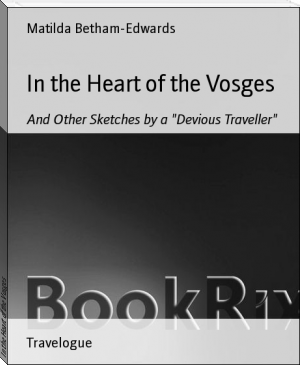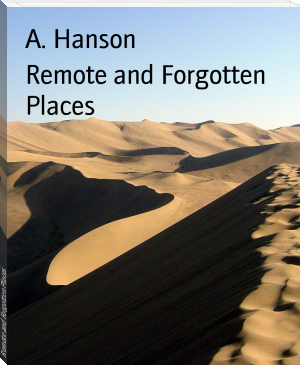Holidays in Eastern France by Matilda Betham-Edwards (best free ebook reader TXT) 📖

- Author: Matilda Betham-Edwards
Book online «Holidays in Eastern France by Matilda Betham-Edwards (best free ebook reader TXT) 📖». Author Matilda Betham-Edwards
A mediaeval writer, Francois de Belleforest, thus describes Besancon:--
"Si par l'antiquite, continuee en grandeur, la benediction de Dieu se cognoit en une lieu, il n'y a ville ni cite en toutes les Gaules qui ayt plus grande occasion de remarquer la faveur de Dieu, en soy que la cite dont nous avions prise le discours. Car, en premier lieu, elle est assise en aussi bonne et riche assiette que ville du monde; estant entoure de riches costeaux et vignobles, et de belles et hautes forets, ayant la riviere du Doux qui passe par le millieu, et enclost pour le plupart d'icelle, estant bien, d'ailleurs fort bien approvisionee. Les fruicts y sont aussi bons, et y a aussi bonne commodite de venaison et de gibier en ceste ville, qu'en autre qu'on sceut choisir. Et puis ce qu'elle est a la cheultes des montagnes, on la tient pour le grenier commun du comte de Bourgogne, comme jadis Sicile estait de l'Itaile. Et s'il etait question d'estimer la vertu d'un peuple, qui s'est longtemps maintenu libre sans ployer la gantelet, ni rien perdu de sa reputation, on peut, a bon droit, faire cas de ceste cite. Et certes de tout temps ceste brave cite a este enviee des tyrans, pour en usurper la domination. Et il n'y a ni eu ni menaces, ni allechement qui ayent sceu esbranler les nobles et libres coeurs besanconnais, pour quicter aucune chose de leurs libertez, quelques couleurs de grandeur et de richesses qu'on leur ayt mis audevant pour se laisser annexer au comte de Bourgogne, et avoir un parlement, et se mettre auxpieds ce qu'il ont aux mains."
CHAPTER VII
ORNANS, COURBET'S COUNTRY, AND THE VALLEY OF THE LOUE.
Let the reader now follow me to Ornans, Courbet's birth and favourite abiding place, and the lovely Valley of the Loue. This is the excursion par excellence from Besancon, and may be made in two ways, either on foot, occupying three or four days, decidedly the most advantageous for those who can do it, or by carriage in a single day, starting very early in the morning, and telegraphing for relays at Ornans the previous afternoon. This is how we managed it, starting at five, and reaching home soon after eight at night. The children accompanied us, and I must say, better fellow-travellers I never had than these mites of sixteen months and three and a-half years. When tired of looking at the cows, oxen, goats, horses and poultry, we passed on the road, they would amuse themselves for an hour by quietly munching a roll, and, when that occupation at last came to an end, they would go to sleep, waking up just as happy as before.
Here I will mention that the great amiability of the French character is no more strongly manifested than in this habit of always having their little children about them. As neither day nor night nurseries exist in France, and head-nurses are equally unheard of, young children are always with their parents. Thus, if visitors call, and papa and mamma happen to be engaged in interesting conversation with them, no attention will be paid to the perpetual noise and interruption of little toddling things, whose place is naturally there. I have heard an animated political discussion go on whilst a boy of two and a half was hammering with a hammer on a wooden box; and no kind of notice was taken by his elders. Such a practice, of course, could only be made tolerable by excessive good-nature, but there is no doubt that our own system is better both for parents and children.
Ornans is not only extremely picturesque in itself, but interesting as the birth and favourite abiding place of the famous painter Courbet; it is also a starting place for the Valley of the Loue, and the source of this beautiful little river, the last only to be seen in fine, dry weather, on account of the steepness and slipperiness of the road. The climate of Franche-Comte is unfortunately very much like our own, being excessively changeable, rainy, blowy, sunny, all in a breath. To-day's unclouded sunshine is no guarantee of fine weather to-morrow, and although, as a rule, September is the finest month of the year here, it was very variable during my stay, with alternations of rain and chilliness. Fine days had to be waited for and seized upon with avidity, whilst the temperature is liable to great and sudden variations.
Ornans we reach after a drive of three hours, amid hills luxuriantly draped with vines and craggy peaks clothed with verdure, here and there wide sketches of velvety green pasture with cattle feeding, haymakers turning over the autumn hay. Everywhere we find haymakers at work, and picturesque figures they are.
Ornans is lovely, and no wonder that Courbet was so fond of it. Nestled in a deep valley of green rocks and vineyards, and built on the banks of the transparent Loue, its quaint spire rising from the midst, it commends itself alike to artist, naturalist, and angler. These old-world houses reflected in the river are marvellously paintable, and the scene, as we saw it after a heavy rain, glowed in the brightest and warmest light.
Courbet's house is situated, not on the river, but by the roadside, on the outskirts of the town, fronting the river and the bright green terraced hills above. It is a low, one-storied house, embosomed in greenery, very rural, pretty, and artistic. In the dining-room we were shown a small statue of the painter by his own hand, giving one rather the idea of a country-squire or sporting farmer than a great artist, and his house--which is not shown to strangers--is full of interesting reminiscences of its owner. In the kitchen is a splendid Renaissance chimney-piece in sculptured marble, fit for the dining-hall of a Rothschild. This, Courbet found in some old chateau near, and, artist-like, transferred it to his cottage. On the walls of the studio are two frescoes he painted in his happier days, before he helped to overthrow the Vendome Column, and thus forfeited the good feeling of his fellow-townsmen. Ornans is clerical to the backbone, and will it be believed?--after this unfortunate affair of the Vendome Column, an exquisite statue, with which Courbet had decorated the public fountain, was thrown down, of course at clerical instigation. Morteau, it must be supposed, being more enlightened, rescued the dishonoured statue, and it now adorns the public fountain of that village. It is, indeed, impossible to give any idea of the vindictive spirit with which poor Courbet was treated by his native village, and, seeing how much he loved it, it must have galled him deeply. We were allowed to wander at will over the house and straggling gardens, having friends in the present occupants, but the house still belongs to the Courbet family, and is not otherwise to be seen.
All this time I was listening, with no little edification, to the remarks of our young driver, who took the keenest interest in Courbet and art generally. He told me, as an instance of the strong feeling existing against Courbet after the events of the Commune, that, upon one occasion when the painter had been drinking a toast with a friend in a cafe, he had no sooner quitted the place than a young officer sprang up and dashed the polluted glass to the ground, shattering it into a dozen pieces. "No one shall henceforth drink out of a glass used by that man," he said, and doubtless he was only echoing the popular sentiment.
Ornans is the birthplace of the princely Perronet de Granvelle (father of the Cardinal whose portrait by Titian adorns the picture-gallery of Besancon), and whose munificent patronage of arts and letters turned that city into a little Florence during the Spanish regime. In the church is seen the plain red marble sarcophagus of his parents, also a carved reading desk and several pictures presented to the church by his son, the Cardinal. There is a curious old Spanish house in the town, a relic of the same epoch. Ornans is celebrated for its cherry orchards and fabrications of Kirsch, also for Absinthe, and its wines. Everywhere you see cherry orchards and artificial terraces for the vines as on the Rhine, not a ledge of hill side being wasted. Gruyere cheese, so called, is also made here, and there are besides several manufactures, nail-forges, wire-drawing mills, and tile-kilns. But none of these interfere with the pastoralness of the scenery, and no wonder that this attracts French artists in the summer time. Lovely walks and drives abound, and the magnificence of the forest trees has been made familiar to us by the landscapes of Courbet, whose name will ever be associated with this quaint village in the Valley of the Loue.
We are now on the high road from Ornans to Pontarlier, and are passing some of the wealthiest little communities in Franche-Comte, Montgesoye, Vuillafans, Lods, all most picturesque to behold, and important centres of industry. Iron foundries, kirsch distilleries, chemical works, and other manufactures maintain these rustic populations, and such isolated little nuclei of trade will doubtless take extraordinary development when the line of railway from Besancon to Pontarlier, by way of Ornans, is completed. At present it is one of the few places that may be described as out of the world, and a veritable paradise for the lover of quiet and rusticity. If we proceed further on the Monthier road, the aspect changes, and we find ourselves in the winding close-shut valley, the narrow turbulent little streams of deepest green tossing over its rocky bed amid hanging vineyards and lofty cliffs. Soon, however, the vine, the oak, the





Comments (0)